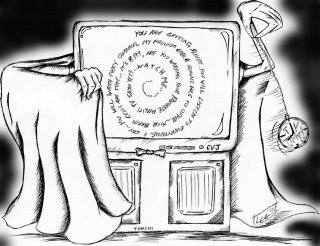

Television and Addiction
In 1997 700 Japanese children were rushed to a hospital for treatment after watching a television program. Japanese television had aired a souped up version of the Pokemon game, complete with flashing lights, bells and whistles. The children were admitted with optically stimulated epileptic seizures. Television can quite obviously affect people.
Advertisers have known for some time now that quick cuts, optical tricks and alike are likely to evoke a powerful results from the viewing audience. MTV taught us all a lesson in visual communication. But do these stimuli really work on the public or are they all too numb when watching television?
Couch potato measurements
The average person spends about three hours a day in front of the TV set. That's roughly half their leisure time. Forty percent of adults admit to watching too much television. The number increases to 70% among teenagers. A full 10% claims they are addicted, couch potatoes with roots.
Addictions of course, are not always confined to substances. Gambling or sex can become addictive and destructive behavior in certain circumstances. Some clinicians claim that television viewing can fall into the same category and it is far more ubiquitous.
People and the reader might nod at this, have often found themselves in conversation with someone in a room, with the TV tuned to nothing of interest in the background, yet their eyes will invariably wander to the set.
Heavy viewers watch nearly eight hours a day. They are pretty likely to be paying attention (65% full attention) and remember the last ad they saw (12% recall). Light viewers, on the other hand, pay less attention (56%) and have lower ad recall scores (6%) So statistics tell us that couch potatoes can be susceptible to the tricks of the commercial trade.
TV: an upper or a downer?
There is ample evidence that couch potatoes are not so easily affected by what they see. Since the 1960s, behaviorists have been testing people's brain functions while exposed to television messages. The findings after forty years of testing are pretty consistent. TV is not speed, it's a downer.
EEG (electroencephalograms) tests show that there is less mental stimulation to the brain with viewing that with reading. Given that reading necessitates mental engagement and active participation, while viewing does not so acutely, this is perfectly reasonable. Moments after sitting down with the set, people begin to relax and disengage from real life. They seem to generally watch longer than they had planned to and heavy viewers report that they enjoyed the programs less than they anticipated.
Viewers report and record a consistent rate of relaxation that exceeds actual viewing time. Drowsiness may linger beyond viewing time, even a depression. Television acts much the way a tranquilizer does. It is very unlike sports and other hobbies, where people generally walk away feeling refreshed.
So TV is numbing and while technical tricks may stimulate the brain in the short term, a heavy viewer is basically a man or woman on a down slope.
Something to think about the next time you allocate media money.
© Media Directors Ink : April 2002

No comments:
Post a Comment